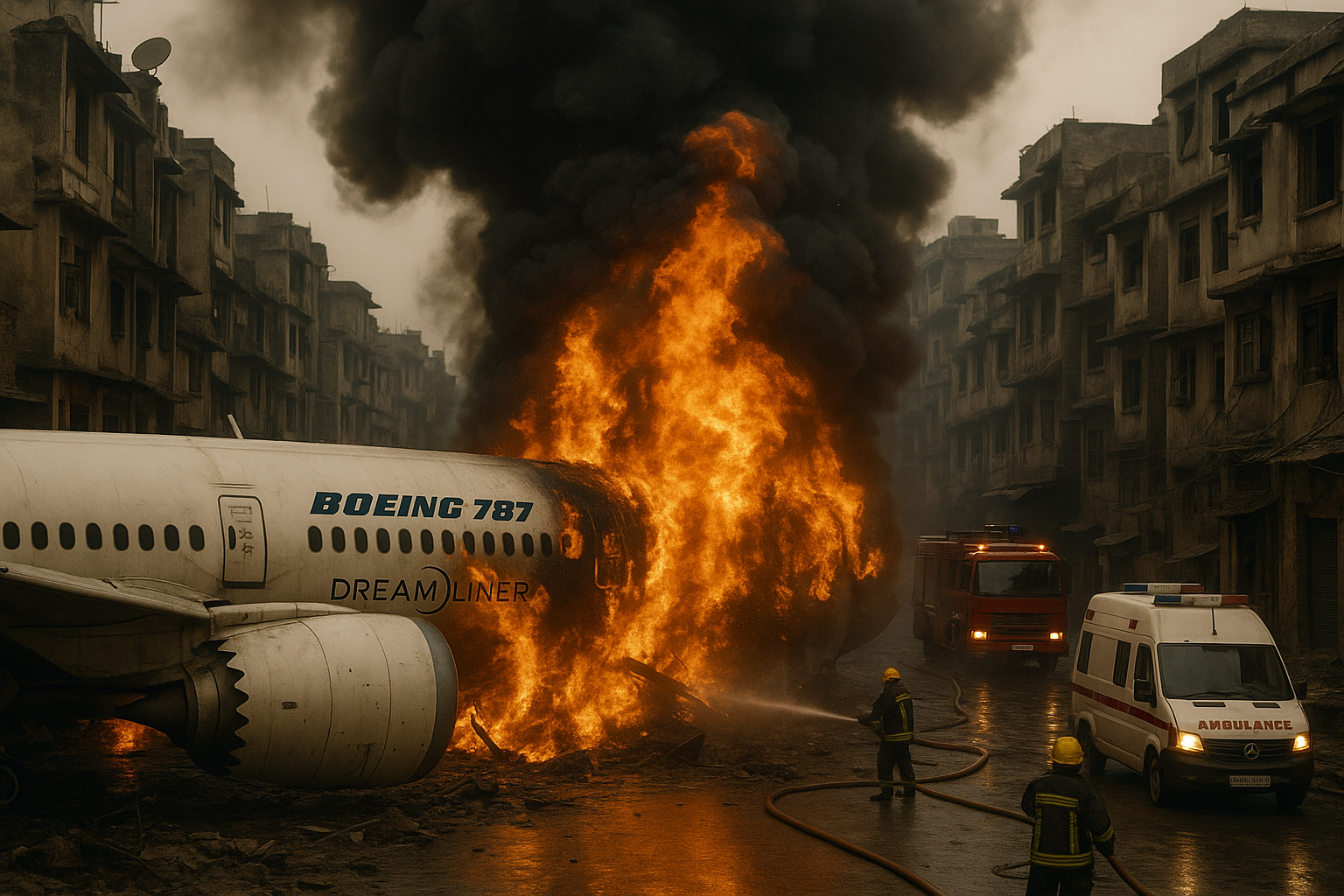1. Flight Profile & Aircraft Details
On June 12, 2025, at approximately 1:38 p.m. IST (08:08 UTC), Air India Flight AI 171, a Boeing 787‑8 Dreamliner registered VT‑ANB, took off from Sardar Vallabhbhai Patel International Airport, Ahmedabad, bound for London Gatwick. The aircraft, delivered in early 2014, was 11 years old and had routinely served long-haul routes.
Moments after liftoff from Runway 23, the crew issued a Mayday call at 1:39 p.m. IST, signaling an emergency. Within seconds, air traffic control lost all communication.
2. Sudden Descent into Meghani Nagar
Eyewitnesses and airport radar data show that the Dreamliner climbed to barely 600 feet before plunging into Meghani Nagar, a densely populated residential district adjacent to the airport (people.com). The aircraft struck the doctors’ hostel dining hall at the campus of B.J. Medical College, exploding into a massive fireball that spewed thick black smoke into the sky.
Visual footage captured horrifying scenes of flaming wreckage amidst residential streets and ambulances rushing victims to nearby hospitals .
3. Manpower Impact: Victims & Survivors
Flight manifest confirmed:
- Total aboard: 242 (230 passengers; 12 crew: 2 pilots, 10 cabin staff)
- Passengers: 169 Indians, 53 Brits, 7 Portuguese, 1 Canadian
- Among passengers was the former Gujarat Chief Minister, Vijay Rupani.
Rescue teams initially recovered 30 to 35 bodies, though the final casualty count remains uncertain amid ongoing recovery efforts. Many remain trapped in the charred wreckage. Hospitals continue tending to a growing number of critically injured, including residents of the doctors’ hostel.
4. Relief & Response in Full Throttle
First Responders:
- Firefighters, ambulances, NDRF (National Disaster Response Force) units (90+ personnel), and local police surged to the scene instantly.
- Ahmedabad Airport halted all flight operations as emergency protocols were activated.
- The airport operator (Adani Group) coordinated with state and municipal agencies to secure the site.
Government Reaction:
- Prime Minister Narendra Modi expressed profound grief, pledging full support from the government .
- The UK government, including Prime Minister Keir Starmer and Buckingham Palace, also extended condolences, as 53 Britons were aboard.
- Other affected nations, including Canada and Portugal, offered assistance.
Air India & Tata Group:
- Air India, now under Tata Group management, immediately activated an emergency helpline, emergency response centre, and family support teams.
- Air India Chairman Natarajan Chandrasekaran and Aviation Minister Kinjarapu Rammohan Naidu confirmed active steps were underway.
Corporate Responsibility:
- Gautam Adani (airport operator) stated: “Our hearts go out… working closely with all authorities and extending full support to families”.
5. Investigations Underway
- India’s DGCA (Directorate General of Civil Aviation) and Aviation Accident Investigation Bureau (AAIB) dispatched teams to extract and analyse the Black Boxes (FDR & CVR).
- Initial reports suggest heavy fuel for the long-haul destination may have intensified the inferno upon impact.
- Boeing acknowledged the incident, sending investigation teams; its stock slid ~7% in early trading.
Technical details such as flight data and cockpit recordings are being studied to determine whether mechanical failure, pilot error, or environmental factors caused the catastrophic descent.
6. Historical Context & Aviation Safety Impacts
- This is the first fatal accident involving a Boeing 787 Dreamliner, a model considered among the safest since its 2011 launch—out of eight incidents, it now records its first hull loss.
- For Air India, it’s the first major hull loss since the 1985 bombing of Flight 182, and the first fatal crash since Air India Express Flight 1344 in Kozhikode (2020), which killed 21.
- Ahmedabad’s proximity to the crash site drew unsettling echoes of previous runway incidents in India, prompting renewed scrutiny of airport safety measures and air traffic protocols.
7. Community Impact & Infrastructure Response
The crash occurred in a densely populated residential area, severely affecting:
- Local residents and medical college dormitories, including significant casualties and missing persons.
- Emergency services collaborated closely, but the intensity of the fire—fuel-fed—complicated early rescue operations.
- Flight cancellations and rerouting at Ahmedabad Airport disrupted regional and international connectivity.
8. Official Statements & Crisis Communication
- Air India stated: “Injured are being taken to nearest hospitals,” while confirming efforts to identify all affected passengers.
- Aviation concrete updates, family outreach, and daily briefings continue through official helplines and Air India’s X (formerly Twitter) platforms .
9. What Comes Next?
Rescue & Recovery
Efforts continue around the clock to recover remains, extract survivors, and secure the site. Structural inspections of the crash area will determine when normalcy can resume.
Technical Investigation
- Retrieval and analysis of the Black Boxes is central.
- Factors under scrutiny: engine performance, flight controls, pilot communications, weather data, fuel load, and potential systems malfunction.
- Boeing, DGCA, AAIB, and global safety authorities are collaborating on a transparent investigation, expected to take several months.
Operational & Regulatory Reforms
Potential audits of:
- Air India’s maintenance and safety protocols, already under review post-Tata’s acquisition.
- Ahmedabad Airport’s airspace management and emergency preparedness.
- Boeing’s 787 model will also come under renewed global scrutiny.
Compensation & Legal Proceedings
Air India is expected to follow Indian legal provisions for compensation to victims’ families; foreign passenger compensation will involve international regulations and agreements.
Conclusion
The Air India Flight AI 171 disaster is a tragic milestone—the first fatal crash of a Boeing 787 since 2011 and a major blow to India’s civil aviation industry. With 242 lives at stake and a residential area devastated, the incident demands fast, decisive action from aircraft manufacturers, aviation regulators, airlines, and local authorities. Families await closure as investigations proceed. Ultimately, the hope is that lessons from this catastrophe will usher in strengthened safety systems, ensuring that modern aircraft like the Dreamliner fulfill their promise of secure and efficient travel.
Estate Brief‘s mission: informing readers with precision, empathy, and insight this article brings you the full context and forward path from a devastating moment in aviation history.




